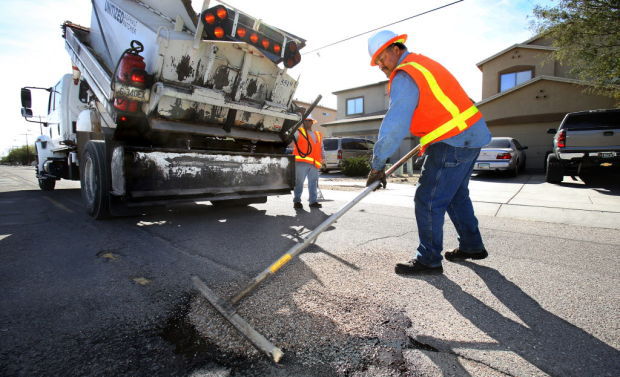Saying it’s the only fair way to distribute limited resources, County Administrator Chuck Huckelberry is proposing a $160 million road bond plan that allocates spending based on each jurisdiction’s assessed value.
That way, taxpayers in each of the five incorporated municipalities and the unincorporated county would benefit proportionally to their contribution toward paying off the bonds, he said.
At Tuesday’s Board of Supervisors meeting, Supervisor Ramón Valadez told Huckelberry to add as much as $200 million in road projects to an anticipated bond election ballot to address the many miles of roads that have fallen into disrepair over the years.
Huckelberry limited his proposal to $160 million because a larger amount could push the county’s secondary property tax over the board’s self-imposed secondary-property-tax limit of 81.5 cents per $100 assessed value, when combined with another $653 million in bonds recommended by a citizens committee.
County transportation officials have estimated as much as 60 percent of the county’s roads are in poor or failed condition. City of Tucson officials estimate that more than 75 percent of lane miles there rank below satisfactory, according to the city’s most recent annual financial report.
“If we want to solve this problem, we have to do it ourselves,” Huckelberry said. “It’s the only option.”
Because repair needs are spread throughout the region, Huckelberry said projects should be distributed based on each area’s share of the county’s overall net assessed property valuation.
Dividing projects up that way would mean nearly 84 percent of road work would be done in either Tucson or the unincorporated areas of the county.
“They will get their fair dollar-for-dollar return,” Huckelberry said.
Supervisor Richard Elías said he supports the bond proposal and the plan to divide the roads portion based on property values.
“Tax equity is a big issue,” Elías said, noting the vast majority of his district lies within incorporated city limits.
He also said the region will increasingly have to rely on local funding to repair and build additional roads.
“It’s clear to taxpayers in Southern Arizona that we’re on our own,” Elías said.
Supervisor Ray Carroll agreed that the county may have no other short-term options other than debt financing through bonds to repair and build roads.
“It’s probably our last hope to get our roads up to adequate condition,” Carroll said.
A longer-term solution, he said, would be to persuade the Arizona Legislature to consider an increase in the gas tax as a way to generate more roads funding.
Arizona distributes fuel and vehicle licensing taxes to cities and counties based on population. The fuel tax, which comprises the largest portion of the distribution, has remained unchanged at 18 cents per gallon since 1990. Local governments are precluded from creating similar taxes.
Pima County received $49 million in combined fuel and licensing-fees funding for the current budget year.
The Legislature rejected a proposal from the governor this year to increase licensing fees and quashed calls from cities and counties to increase fuel taxes.
“They won’t even talk about referral to a ballot initiative,” Carroll said, adding that voters should be allowed to weigh in on the issue.
Supervisor Ally Miller, however, said she doesn’t support borrowing to pay for road repairs.
“I think it’s absolutely irresponsible and reckless for Pima County,” Miller said.
She compared using debt financing to pay for road repairs to “using a credit card to buy groceries.” Miller’s concern is that taxpayers would be paying off the ten-year bonds proposed to fund the road projects long after the repairs have worn out.
“In Pima County, road repairs last two to three years,” she said.
Huckelberry said that’s inaccurate, noting that repairs can last from eight to 20 years, depending on the materials and method used.
Miller said the county administration needs to first find areas to cut spending before asking taxpayers to approve more debt.
She suggested the county stop providing $15 million per year to the University of Arizona College of Medicine in support of graduate medical education.
“I would cut that out immediately and divert the money to road repairs,” Miller said.
She also criticized the county’s $6.1 million in annual support of the Sun Tran and Sun Van transit services, which are paid from the transportation budget.
“Reckless and irresponsible — that’s how this county has been run for 20 years,” Miller said. “I don’t trust them with more gas taxes; I don’t trust them with more bonds.”
Elías said the county has done well with past bonds, noting the projects have created public assets and helped the economy.
“Ultimately, the 2004 bond really helped this community in the most difficult recession we’ve had since the 1930s,” he said.
Elías said the diminishing support from the state leaves the county with few options other than asking the public to support taking on more debt.
“This is where we really start to understand what our community values and how we can address those needs,” Elías said.
County voters previously passed bond plans in 1997, 2004, 2006 and 2014.
Huckleberry said passage of the complete bond plan would require an increase in the secondary property tax rate to 81 cents per $100 of assessed value, up from the current rate of 70 cents.
Supervisors are scheduled to discuss a finalized bond proposal at the April 21 meeting.





